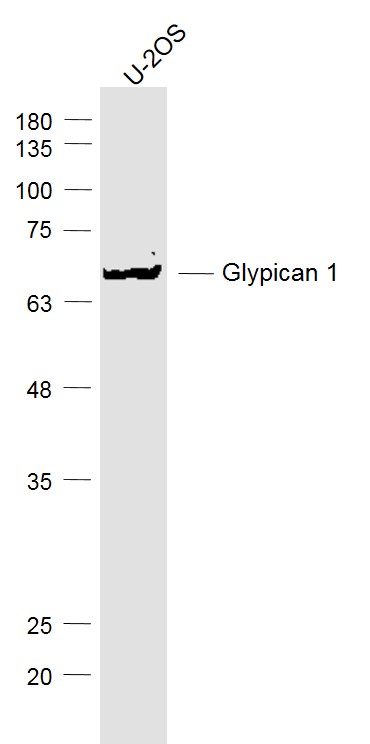
Rabbit Anti-Glypican 1 antibody
FLJ38078; glypican; glypican1; GPC 1; Glypican-1; GPC1; Glypican proteoglycan 1; Gpc1; GPC1_HUMAN; Secreted glypican-1.
View History [Clear]
Details
Product Name Glypican 1 Chinese Name 磷脂酰基醇蛋白聚糖1抗体 Alias FLJ38078; glypican; glypican1; GPC 1; Glypican-1; GPC1; Glypican proteoglycan 1; Gpc1; GPC1_HUMAN; Secreted glypican-1. Research Area Cell biology immunology Immunogen Species Rabbit Clonality Polyclonal React Species (predicted: Human, Mouse, Rat, Chicken, Cow, Sheep, ) Applications WB=1:500-2000
not yet tested in other applications.
optimal dilutions/concentrations should be determined by the end user.Theoretical molecular weight 62kDa Cellular localization cytoplasmic The cell membrane Extracellular matrix Secretory protein Form Liquid Concentration 1mg/ml immunogen KLH conjugated synthetic peptide derived from human Glypican 1 : 401-500/558 Lsotype IgG Purification affinity purified by Protein A Buffer Solution 0.01M TBS(pH7.4) with 1% BSA, 0.03% Proclin300 and 50% Glycerol. Storage Shipped at 4℃. Store at -20 °C for one year. Avoid repeated freeze/thaw cycles. Attention This product as supplied is intended for research use only, not for use in human, therapeutic or diagnostic applications. PubMed PubMed Product Detail Cell surface heparan sulfate proteoglycans are composed of a membrane-associated protein core substituted with a variable number of heparan sulfate chains. Members of the glypican-related integral membrane proteoglycan family (GRIPS) contain a core protein anchored to the cytoplasmic membrane via a glycosyl phosphatidylinositol linkage. These proteins may play a role in the control of cell division and growth regulation. [provided by RefSeq, Jul 2008]
Function:
Cell surface proteoglycan that bears heparan sulfate. Binds, via the heparan sulfate side chains, alpha-4 (V) collagen and participates in Schwann cell myelination (By similarity). May act as a catalyst in increasing the rate of conversion of prion protein PRPN(C) to PRNP(Sc) via associating (via the heparin sulfate side chains) with both forms of PRPN, targeting them to lipid rafts and facilitating their interaction. Required for proper skeletal muscle differentiation by sequestering FGF2 in lipid rafts preventing its binding to receptors (FGFRs) and inhibiting the FGF-mediated signaling.
Subcellular Location:
Cell membrane; Lipid-anchor, GPI-anchor; Extracellular side. Endosome. Note=S-nitrosylated form recycled in endosomes. Localizes to CAV1-containing vesicles close to the cell surface. Cleavage of heparan sulfate side chains takes place mainly in late endosomes. Associates with both forms of PRNP in lipid rafts. Colocalizes with APP in perinuclear compartments and with CP in intracellular compartments. Associates with fibrillar APP Abeta peptides in lipid rafts in Alzheimer disease brains.
Secreted glypican-1: Secreted, extracellular space.
Post-translational modifications:
S-nitrosylated in a Cu(2+)-dependent manner. Nitric acid (NO) is released from the nitrosylated cysteines by ascorbate or by some other reducing agent, in a Cu(2+) or Zn(2+) dependent manner. This free nitric oxide is then capable of cleaving the heparan sulfate side chains.
N- and O-glycosylated. N-glycosylation is mainly of the complex type containing sialic acid. O-glycosylated with heparin sulfate. The heparan sulfate chains can be cleaved either by the action of heparanase or, degraded by a daaminative process that uses nitric oxide (NO) released from the S-nitrosylated cysteines. This process is triggered by ascorbate, or by some other reducing agent, in a Cu(2+)- or Zn(2+) dependent manner. Cu(2+) ions are provided by ceruloproteins such as APP, PRNP or CP which associate with GCP1 in intracellular compartments or lipid rafts.
This cell-associated glypican is further processed to give rise to a medium-released species.
DISEASE:
Note=Associates (via the heparan sulfate side chains) with fibrillar APP-beta amyloid peptides in primitive and classic amyloid plaques and may be involved in the deposition of these senile plaques in the Alzheimer disease (AD) brain.
Note=Misprocessing of GPC1 is found in fibroblasts of patients with Niemann-Pick Type C1 disease. This is due to the defective deaminative degradation of heparan sulfate chains.
Similarity:
Belongs to the glypican family.
SWISS:
P35052
Gene ID:
2817
Database links:Entrez Gene: 2817 Human
Entrez Gene: 14733 Mouse
Omim: 600395 Human
SwissProt: P35052 Human
SwissProt: Q9QZF2 Mouse
Product Picture
Partial purchase records(bought amounts latest0)
No one bought this product
User Comment(Total0User Comment Num)
- No comment



 +86 571 56623320
+86 571 56623320




